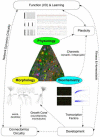Towards the automatic classification of neurons
- PMID: 25765323
- PMCID: PMC4417416
- DOI: 10.1016/j.tins.2015.02.004
Towards the automatic classification of neurons
Abstract
The classification of neurons into types has been much debated since the inception of modern neuroscience. Recent experimental advances are accelerating the pace of data collection. The resulting growth of information about morphological, physiological, and molecular properties encourages efforts to automate neuronal classification by powerful machine learning techniques. We review state-of-the-art analysis approaches and the availability of suitable data and resources, highlighting prominent challenges and opportunities. The effective solution of the neuronal classification problem will require continuous development of computational methods, high-throughput data production, and systematic metadata organization to enable cross-laboratory integration.
Keywords: big data; machine learning; metadata; neural classification; standardization.
Copyright © 2015 Elsevier Ltd. All rights reserved.
Figures



References
-
- Cajal SR. El nuevo concepto de la histología de los centros nerviosos. Rev. Cienc. Méd. 1892;18:457–476.
-
- Markram H. The Human Brain Project. Sci. Am. 2012;306:50–55. - PubMed
-
- Sugino K, et al. Molecular taxonomy of major neuronal classes in the adult mouse forebrain. Nat. Neurosci. 2006;9:99–107. - PubMed
Publication types
MeSH terms
Grants and funding
LinkOut - more resources
Full Text Sources
Other Literature Sources

